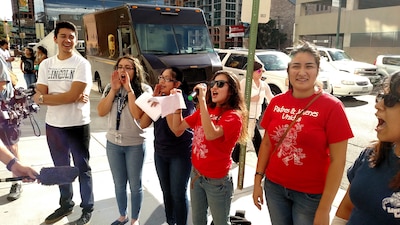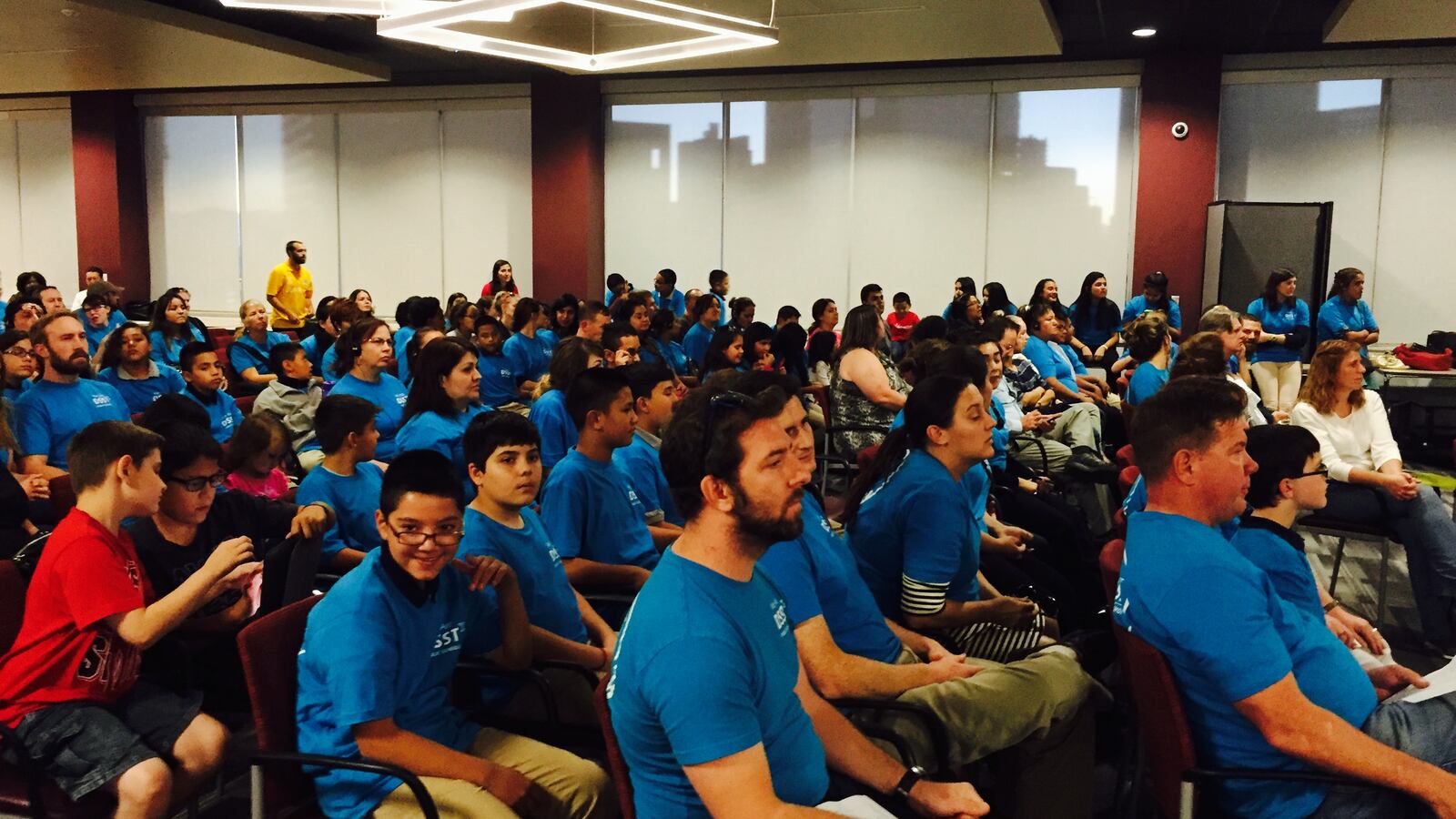Editor’s note: This story was updated at 4 p.m. Friday, Oct. 16 with reaction from school leaders, activists.
Faced with tough choices and intense lobbying, the Denver school board took its own path Thursday in deciding to place three new middle schools — two charters and one district-run school — in available space in two southwest Denver district buildings.
The board majority took the unusual step of rejecting a staff recommendation on the placements, taking an alternate course that drew applause from some and jeers from those opposed to charter school expansion and multiple schools on a single campus.
Last week, DPS staff recommended that high-performing charter school network DSST open a middle school in underutilized space on the Lincoln High School campus. At the same time, it urged that district-run Bear Valley International School take over the building currently housing Henry World Middle School, which is being phased out after a long period of struggles.
The board, however, opted to move just-launched charter school Compass Academy onto the Lincoln High campus, and put Bear Valley and DSST under the same roof at Henry. All three middle schools are to open their doors next fall.
“I think the final outcome is going to improve the odds for those kids in my district who don’t have access to a high-quality program,” said board member Rosemary Rodriguez, who represents southwest Denver and was the driving force behind the adopted plan. “… This is tough. This was tough because the change is almost radical. It’s significant.”
The result disappointed but did not surprise Lincoln students, parents and teachers who staged a high-profile campaign to fight placing any middle school in the building. DPS officials said declining enrollment has left plenty of room for a quality middle school the neighborhood needs. The only question going into Thursday was which middle school would end up there.
The votes also raise questions about whether DSST and the Bear Valley school can co-exist peacefully, and whether the two schools can draw enough students to both flourish. Board member Arturo Jimenez was highly critical of the “very rushed” decision to co-locate a DSST school on the Henry campus, which was opposed by Bear Valley school organizers.
“I raise my concern and strong disdain for this board’s decision with a week’s notice to place a colocation up for a vote without giving the community a full opportunity to discuss this option,” said Jimenez, the board’s consistent dissenting voice.
The votes were 6-1 on the placements at Henry, with Jimenez the lone “no” vote, and 6-0 on the Lincoln plan after he left the meeting.
Complex circumstances
Few recent issues have vexed the board like the southwest middle school decision, thanks to a complex set of circumstances. The race for the space pit charter schools against district-cultivated schools, involved the always sensitive issue of co-locating schools and represented the first time the district has relied on a new policy for choosing new school sites.
In recommending DSST for Lincoln, district staff cited its high academic performance, alignment with many district priorities and long waiting lists. That area of the southwest region, the staff reasoned, is in greatest need of a high-performing school. Staff lauded Bear Valley’s strong leadership and plan, harmony with district priorities and demand in urging a Henry placement.
But that scenario left Compass Academy, a charter school that opened this fall with a sixth-grade class in temporary space at Kepner Middle School, with no permanent home.
Board members pushed back, viewing Compass as a good fit for Lincoln with its seal of biliteracy, strong English language development and promise to forge strong bonds with the district-run high school.
The school’s founding chair, Mary Seawell, is a senior program officer with the Denver-based Gates Family Foundation and a former DPS board president. Compass executive director Marcia Fulton formerly led the Odyssey School, an expeditionary learning school.
Rodriguez also championed putting the two schools in Henry, saying it represents an opportunity to put “two wonderful programs” in a building that can accommodate both.
Board president Happy Haynes criticized Jimenez’s “rhetoric around privatization.”
“This has been portrayed as some sort of a corporate takeover,” she said. Rather, she said charter school organizers are people who “live in our communities who come forward with ideas about how to better serve our students.”
‘Fix Lincoln First!’
At a packed public hearing Monday night, community members and a parade of representatives of the schools vying for space took turns arguing their points.
Lincoln High School students and parents marched from Civic Center Park to district headquarters carrying placards and chanting, “Fix Lincoln First!” DSST students clad in matching T-shirts told stories about teachers who are “strict and nice,” doing your best and aspirations to attend Stanford, Yale or Harvard.

A group representing Bear Valley International School took a decidedly different tone, urging that it not be forced to share space with a DSST school in the Henry building. One speaker argued Bear Valley would “provide options not for high performers but for every child,” a not-so-veiled reference to the accusation that high-performing charters skim the best students.
Bear Valley principal Lindsay Meier said Friday the two schools sharing one building brings logistical and recruitment challenges. DSST offers a well-known, high-quality program and Bear Valley will be vying for the same students, she said.
“I liken it to the being in the grocery store, and are you going to buy the Oreos or the off-brand?” she said. “We are going to be that off-brand that is going to make a great name for ourselves, and we are committed to doing that.”
“It was a really difficult decision for the board of education to make,” said Meier, the district’s choice to lead the new school after a stint as assistant principal at Skinner Middle School in northwest Denver. “I would just say that our community has fought hard for this, and regardless of the colocation, we are going to open strong and we are committed to doing everything we promised to do in our plan.”
The board’s decision to put a middle school in Lincoln will give fuel to critics who contend the district does not truly listen to the communities it serves.
“We expected the outcome because we knew the outcome from the beginning,” said Ricardo Martinez, co-executive director of Padres & Jóvenes Unidos, an activist group that spearheaded the fight to keep a middle school out of Lincoln.
The district, however, has only so much space available and has prioritized lifting the quality of southwest Denver middle schools.
Haynes said the board did hear community voices.
“This has been tough and emotional issue for many of us,” she said.
New policy tested
According to DPS, enrollment at Lincoln has declined from about 1,900 in 2009 to 1,371 this school year, giving the building ample room to accommodate a 300-student middle school.
To hear students and many teachers tell it, that is far from the reality. Over the past few months, complaints have surfaced about overcrowding in the hallways, cafeteria and parking lot. Critics of co-location contend Lincoln has been denied resources afforded other schools. DPS says Lincoln was one of the largest beneficiaries of a 2013 school bond, getting $4.5 million for improvements.
The process is the first test of a new DPS policy, adopted in January, that ties new school location decisions to the schools’ academic performance, student enrollment patterns, community demand and other district priorities.
The board rejected an application for a district-run dual language Spanish and English school, Academia Lincoln, that wanted to open on the high-school campus. District staff faulted the school’s leadership for lacking details on the program, and for not showing as much community demand as the other contenders.

